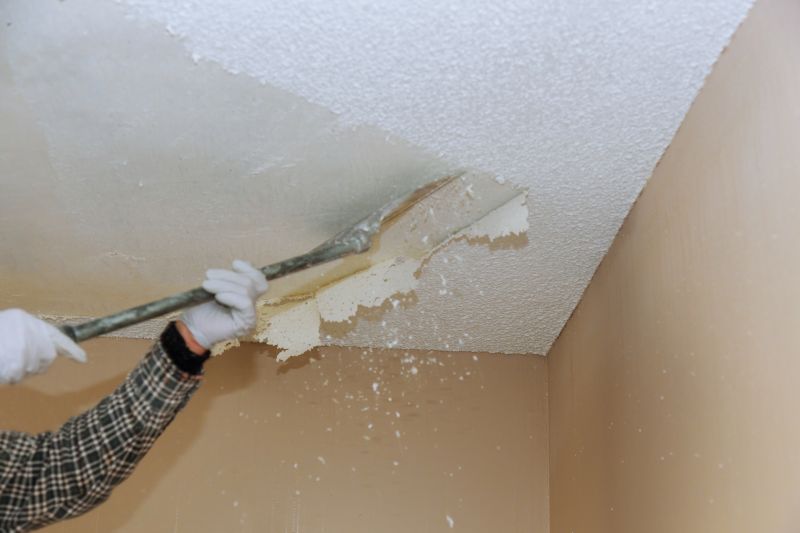Leading Products For Removing Stipple Ceilings With Ease
Choose from top-rated supplies designed to reduce effort and improve safety during your stipple ceiling removal project.
 Removing stipple ceilings, also known as popcorn ceilings, can be a challenging task that requires the right set of tools and products. Homeowners and DIY enthusiasts often seek effective solutions to safely and efficiently strip away textured surfaces, revealing a smooth ceiling underneath. The process typically involves wetting the textured surface to loosen it, followed by scraping or sanding to remove residual material. Having the appropriate products can make this process safer, cleaner, and more manageable.
Removing stipple ceilings, also known as popcorn ceilings, can be a challenging task that requires the right set of tools and products. Homeowners and DIY enthusiasts often seek effective solutions to safely and efficiently strip away textured surfaces, revealing a smooth ceiling underneath. The process typically involves wetting the textured surface to loosen it, followed by scraping or sanding to remove residual material. Having the appropriate products can make this process safer, cleaner, and more manageable.
Top Overall Option
Multi-Purpose Ceiling Scraper Kit
A versatile scraper kit designed specifically for textured ceiling removal, featuring adjustable blades, ergonomic handles, and compatible scrapers for different surface types. It provides a balanced combination of power and control, making it suitable for various removal techniques while minimizing damage to the ceiling underneath.
Types of Products For Stipple Ceiling Removals
Spray Detachment Solutions
Chemical or water-based sprays formulated to soften textured ceilings for easier removal, reducing the need for aggressive scraping.
Manual Ceiling Scrapers
Handheld tools with flat blades designed to manually scrape away texture with precision and control.
Power Sanders
Electric sanding tools equipped with appropriate pads for smoothing surfaces after removal or for prepping ceilings.
Heat Guns
Devices that emit controlled heat to loosen texture layers, making scraping easier and reducing dust.
Protective Gear Sets
Comprehensive safety equipment including masks, goggles, and coveralls to ensure safety during removal.
Drop Cloths and Tarps
Heavy-duty coverings to protect floors and furniture from debris and dust during the removal process.
Vacuum Attachments
Specialized vacuum tools or attachments that help contain dust and debris as you work.
Chemical Strippers
Paint or texture removers formulated to dissolve coating layers without excessive scraping.
Extension Poles
Long handles that extend reach for high ceilings, reducing the need for ladders.
Moistening Sprays
Sprays designed to lightly dampen textured surfaces, aiding in easier removal with less dust.
Sanding Blocks
Handheld abrasive tools for smoothing any residual roughness after removal.
Ladders and Scaffolding
Support tools to safely access high ceilings during removal tasks.
Paint and Primer
Finishing products to prepare the ceiling surface after removal for painting or refinishing.
Texture Removal Discs
Abrasive discs compatible with power tools, designed to remove stubborn texture layers efficiently.
Popular Choices
Commonly used to soften popcorn textures, making removal less labor-intensive.
Widely favored for controlled removal, especially in detailed or delicate areas.
Popular for smoothing surfaces after removal or for preparing ceilings for repainting.
Trusted by many for their ability to loosen textured surfaces with minimal dust.
Essential for safety, these are often recommended to ensure safe removal practices.
Commonly used to contain debris and protect flooring during removal projects.
Popular for reducing airborne dust, making cleanup easier.
Frequently chosen for their ability to dissolve textured coatings with less physical effort.
Useful for reaching high ceilings, reducing the need for ladders or scaffolding.
Popular for their role in softening textures prior to scraping.
Frequently used for finishing touches after removal for a smooth surface.
Commonly employed to safely access high areas during removal.
Popular for preparing ceilings after removal for a fresh finish.
Widely used with power tools to handle stubborn textures efficiently.
Many products designed for stipple ceiling removal focus on softening or loosening the texture, reducing dust, and minimizing damage to the underlying surface. These include specialized sprays, scrapers, and protective gear. Proper preparation and the right tools can significantly impact the ease and quality of the removal process. It's important to select products that are compatible with your ceiling material and suitable for your removal method.
Safety considerations are paramount when tackling stipple ceiling removal. Using protective gear such as goggles, masks, and coveralls helps prevent inhalation of dust and debris. Additionally, choosing products that contain fewer harmful chemicals can contribute to a safer working environment. Proper ventilation and disposal of debris are also essential components of a successful removal project.
Overall, investing in quality products tailored for stipple ceiling removal can streamline the process, reduce mess, and improve safety. Whether you're undertaking a small patch or a full ceiling overhaul, the right tools and supplies can make a significant difference in achieving a smooth, clean surface ready for finishing or repainting.
Key Buying Considerations
- Type of ceiling texture and its density to select appropriate removal tools.
- Safety features such as dust containment and protective gear to ensure safe operation.
- Compatibility of removal products with ceiling materials like drywall or plaster.
- Ease of use and ergonomic design for prolonged or detailed work.
- Effectiveness of chemical or spray solutions for softening textures.
- Availability of adjustable or extendable tools for high ceilings.
- Dust control options to minimize airborne debris during removal.
- Durability and quality of scrapers, blades, and power tools for repeated use.
- Compatibility of sanding or finishing tools with your existing equipment.
- Disposal and cleanup considerations, including debris bags or vacuums.
- Project scope and whether a kit or individual components are more suitable.
- Budget constraints and cost-effectiveness of the selected products.
- User reviews and ratings to gauge product performance and reliability.
- Environmental and chemical safety of removal products, especially if working indoors.
- Availability of replacement parts or accessories for long-term use.
